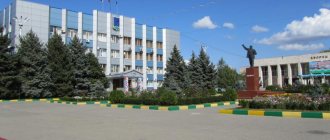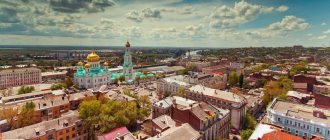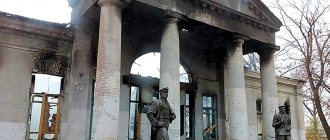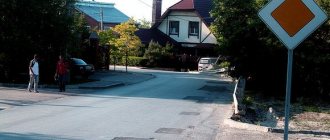Geographical position
In the south of Russia, on the East European Plain and the north of the Caucasus, there is a large subject of the Federation - the Rostov region. Its area is just over 1 million square meters. km, and this is 33rd among all regions of the country. The region borders on the Voronezh and Volgograd regions, Ukraine, Krasnodar and Stavropol territories and Kalmykia. The relief of the region is generally flat: from a slight elevation in the north to a depression in the south. The region is rich in hydro resources. One of the largest rivers in Europe - the Don - and its two tributaries - the Manych and Donets - flow here, there is a large Tsimlyansk reservoir and several lakes. The region is located within the steppe zone; in the south there is a transition to semi-deserts. Most of the territory is occupied by fertile agricultural land, there are few forests, mostly green areas are located in the floodplains of rivers. For many centuries, the life of the population of the Rostov region has been associated with the cultivation of crops and livestock.
Rostov region. Districts
The Rostov region is located in the south of the European part of the Russian Federation, which is under the jurisdiction of the Southern Federal District. In the east it borders with the Volgograd region, with the Voronezh region in the north, in the south of the region with the Stavropol and Krasnodar regions and the Republic of Kalmykia, with the Lugansk and Donetsk regions of Ukraine in the west.
The distance from the region to the capital of Russia, Moscow, is 755 km. One of the largest rivers in Europe, the Don (1,870 kilometers long), flows through the region, on which the Tsimlyansk Reservoir (volume 24 billion m³) is located. The main tributaries of the Don are navigable: the Manych and Seversky Donets rivers. Lakes predominate only 0.4% throughout the region. The southwestern part of the region is washed by the Sea of Azov (in particular, the Taganrog Bay).
Rostov region. Map (The dotted line indicates the boundaries of the area on the map)
According to the State Statistics Committee of Russia for 2012, the population of the region is 4,260,645 people. The population density is 42 people/km2. According to the results of the socio-economic development rating of the Russian Ministry of Economic Development, the Rostov region occupies an honorable 39th place. Compared to 2011, the Rostov region moved up 8 positions.
Districts of the Rostov region and regional centers:
|
|
Administrative-territorial division of the Rostov region Map by district
Cities and towns:
|
|
|
Climate and ecology
The Rostov region is located in a zone of temperate continental steppe climate with mild, short winters and long, hot summers. The region has a lot of sunshine; there are approximately 2,100 hours of such weather per year. The average annual temperature is 10 degrees Celsius. Winter in the region begins in December and lasts until the end of February, the coldest month is January, when the thermometer drops to minus 5 at night. Snow cover does not last long, on average 203 weeks for the entire season. Winter in the Rostov region is wet and windy. Spring begins in the region at the end of February and lasts 2 months; plants begin to bloom already in March; in April the thermometer during the day rises to +15 degrees, sometimes even higher.
The longest season in the region is summer. It starts in May and ends at the end of September. The hottest month is July, when the temperature averages about 25-30 degrees Celsius. Autumn in the region is short and dry, in October and November the temperature drops to 10 degrees Celsius, the sky becomes gloomy more often and the wind blows often. The southeastern territories are distinguished by a more pronounced sharply continental climate and here winters are colder and summers are significantly hotter than in other parts of the region. These climatic features affect the population density of the Rostov region and its distribution. The ecological situation in the region is not much different from the situation in all southern regions of the country. Nature is polluted by cars and people; there are no harmful industries here, but industry has a negative impact on water and air, especially in the Rostov region.
Population dynamics
Systematic calculations of the population of the Rostov region began in 1959. At that time, just over 3 million people lived here. During Soviet times, the region showed a steady increase in the number of residents, on average several tens of thousands of people per year. In 1997, almost 4.5 million people lived here. But with the advent of change and economic difficulties, the number of residents in the region begins to decline. There are 4.2 million people here in 2021.
Districts of the region and population distribution
Since 2005, the region has been divided into 12 cities and 43 districts, in which there are 18 urban settlements and 390 villages. Statistics show that the population of the districts of the Rostov region is heterogeneous. The northern and southeastern parts are much less populated than the central territories. The average population density of the region is 42 people per square meter. km. And the highest average population density in the Rostov region is observed in the capital area, here this figure ranges from 2 to 2.5 thousand people per square meter. km. Most of the population is settled in cities (2.9 million people); there is a gradual outflow of rural residents to the cities of the region. The largest cities in the Rostov region in terms of population are the capital of the region (1.1 million people), Taganrog (250 thousand people), Shakhty (236 thousand people), Novocherkassk (170 thousand people), Volgodonsk (170 thousand . people).
Map of the Rostov region with cities and districts
| 1. Rostov-on-Don | 15. Proletarsk city (Proletarsky district) | 29. Kashary sl. (Kashar district) | 43. Belaya Kalitva city (Belokalitvinsky district) |
| 2. Pokrovskoye village (Neklinovsky district) | 16. Tselina pst (Tselinsky district) | 30. Taganrog | 44. Zernograd city (Zernogradsky district) |
| 3. Chaltyr village. (Myasnikovsky district) | 17. Ust-Donetsk rp (Ust-Donetsk region) | 31. Novoshakhtinsk | 45. Cherished p. (Zavetinsky district) |
| 4. Oblivskaya st. (Oblivsky district) | 18. Tsimlyansk city (Tsimlyansky district) | 32. Mines | 46. Zimovniki pst (Zimovnikovsky district) |
| 5. Quarries rp (Oktyabrsky district) | 19. Chertkovo pst (Chertkovsky district) | 33. Azov city (Azov region) | 47. Kagalnitskaya st. (Kagalnitsky district) |
| 6. Oryol Pst (Oryol District) | 20. Veshenskaya st. (Sholokhovsky district) | 34. Aksai city (Aksai district) | 48. Gluboky rp (Kamensky district) |
| 7. Morozovsk city (Morozovsky district) | 21. Zhirnov rp (Tatsinsky district) | 35. Novocherkassk | 49. Egorlykskaya station. (Egorlyksky district) |
| 8. Millerovo city (Millerovsky district) | 22. Tarasovsky pst (Tarasovsky district) | 36. Kamensk-Shakhtinsky | 50. Dubovskoye village (Dubovsky district) |
| 9. Kuibyshevo village (Kuibyshevsky district) | 23. Rodionovo-Nesvetaiskaya village. (Rodionovo-Nesvetaysky district) | 37. Volgodonsk | 51. Bokovskaya st. (Bokovsky district) |
| 10. Uglerodovsky district (Krasnosulinsky district) | 24. Repair village. (Remontnensky district) | 38. Bataysk city | 52. Sholokhovsky district (Belokalitvinsky district) |
| 11. Bolshaya Martynovka sl. (Martynovsky district) | 25. Salsk city (Salsky district) | 39. Gukovo city | 53. Kazan st. (Verkhnedonsky district) |
| 12. Matveev Kurgan pst (Matveevo-Kurgan district) | 26. Semikarakorsk city (Semikarakorsk district) | 40. Donetsk | 54. Vesely pst (Veselovsky district) |
| 13. Peschanokopskoe village. (Peschanokopsky district) | 27. Soviet Art. (Sovetsky district) | 41. Zverevo city | 55. Romanovskaya st. (Volgodonsk region) |
| 14. Milyutinskaya station (Milyutinsky district) | 28. Krasny Sulin city (Krasnosulinsky district) | 42. Bagaevskaya st. (Bagaevsky district) | 56. Konstantinovsk city (Konstantinovsky district) |
Satellite map of the Rostov region
Switching between the satellite map of the Rostov region and the schematic one is done in the lower left corner of the interactive map.
Rostov region - Wikipedia:
Date of formation of the Rostov region:
September 13, 1937
Population of the Rostov region:
4,181,486 people.
(January 1, 2021) Telephone code of the Rostov region:
863
Area of the Rostov region:
100,800 km²
Vehicle codes of the Rostov region:
61,161, 761
Districts of the Rostov region
Azov • Aksai • Bagaevsky • Belokalitvinsky • Bokovsky • Verkhnedonsky • Veselovsky • Volgodonsk • Dubovsky • Egorlyksky • Zavetinsky • Zernogradsky • Zimovnikovsky • Kagalnitsky • Kamensky • Kasharsky • Konstantinovsky • Krasnosulinsky • Kuibyshevsky • Martynovsky • Matveevo-Kurgansky • Millerovsky • Milyutinsky • Morozovsky • Myasnikovsky • Neklinovsky • Oblivsky • Oktyabrsky • Orlovsky • Peschanokopsky • Proletarsky • Remontnensky • Rodionovo-Nesvetaysky • Salsky • Semikarakorsky • Sovetsky • Tarasovsky • Tatsinsky • Ust-Donetsk • Tselinsky • Tsimlyansky • Chertkovsky • Sholokhovsky.
Cities of the Rostov region - list of cities in alphabetical order
Population of cities in the Rostov region in 2017.
Azov city
— City population: 81,335 people.
Aksai city
- City population: 44828 people.
City of Bataysk
- City population: 124,705 people.
City of Belaya Kalitva
- City population: 40,831 people.
City of Volgodonsk
- City population: 171,471 people.
City of Gukovo
- City population: 66,332 people.
City of Donetsk
- City population: 48,428 people.
City of Zverevo
- City population: 21,126 people.
City of Zernograd
- City population: 24886 people.
City of Kamensk-Shakhtinsky
- City population: 89,657 people.
City of Konstantinovsk
- City population: 17,317 people.
City of Krasny Sulin
- City population: 38,567 people.
City of Millerovo
- City population: 35,540 people.
City of Morozovsk
- City population: 25,467 people.
City of Novocherkassk
- City population: 168,766 people.
City of Novoshakhtinsk
- City population: 108,782 people.
City of Proletarsk
- City population: 19,290 people.
City of Rostov-on-Don
- City population: 1125299 people.
City of Salsk
- City population: 58,179 people.
City of Semikarakorsk
- City population: 22118 people.
Taganrog city
- City population: 250,287 people.
City of Tsimlyansk
- City population: 14463 people.
City of Shakhty
- City population: 235,492 people.
Rostov region
located in the south of Russia in the area of the Don River delta on the coast of the Azov Sea. The Rostov region borders the Volgograd and Voronezh regions, the Krasnodar and Stavropol territories and the Republic of Kalmykia. It also shares a common state border with Ukraine. The Don and several other smaller rivers flow through the region.
The Rostov region is considered the land of the Don Cossacks and the main Russian gateway to the Caucasus. The administrative center is the large port city of Rostov-on-Don, which should not be confused with the ancient city of Rostov, located between Moscow and Yaroslavl. The confusion is compounded by the fact that Rostov-on-Don is usually referred to simply as Rostov, while Rostov is usually called the Great Rostov.
Rostov-on-Don
is closely associated with the Cossacks and is also referred to as the "Gateway to the Caucasus". In 2021, the city served as the venue for the FIFA World Cup.
A popular tourist destination in the Rostov region is the city of Taganrog
, founded by Peter the Great as a naval base. The most famous landmark of Taganrog is the birthplace of the writer Anton Chekhov, which has now been turned into a museum. Author Mikhail Sholokhov is also associated with the region and the village of Veshenskaya, where the Sholokhov Spring Festival is held annually, dedicated to Sholokhov’s masterpiece “Quiet Flows the Don,” which earned the author the Nobel Prize in Literature.
This port city on the Taganrog Bay of the Sea of Azov can trace its centuries-old history back to the days when it was an ancient Greek outpost mentioned by the historian Herodotus. However, the modern city called Taganrog can be given a specific founding date - September 12, 1698. On this day, Peter the Great issued a decree on the creation of a naval base for the Azov flotilla of the Black Sea Fleet. The port's focus later shifted from a military to a commercial function, especially in terms of exporting Russian grain.
What to see in the Rostov region
To see the main attractions of the region, you should first go to the regional center. There, in the center of the city, the Rostov Cathedral of the Nativity of the Blessed Virgin Mary rises. Another interesting temple is the church of an Armenian monastery, built at the end of the 18th century.
There are also noteworthy historical and architectural monuments in other cities in the region. For example, in Taganrog there is one of the largest historical and architectural reserves in Russia. No less interesting is the nature reserve in Veshenskaya - Sholokhov’s place of residence.
Sights of the Rostov region
Sarkel, Tanais, Old Station, Tchaikovsky House, Alexander Garden, Kobyakovo Settlement, Tachanka, Church of the Intercession of the Blessed Virgin Mary, Matveev Kurgan, Monument to Ermak, Azov Fortress, Provalskaya Steppe, Church of St. George the Victorious, Alexander Column, Donskoy Starocherkassky Monastery, Trinity Church, Aksai customs outpost, Iversky Convent, Church of the Life-Giving Trinity, Church of All Saints, Church of the Nativity, Alekseevsky Gate, Lutheran Church, Church of the Ascension, Church of the Intercession, Postal station of the 19th century.
Demographic indicators of the Rostov region
As of 2021, the birth rate in the region is increasing and amounts to just over 12 newborns for every thousand inhabitants. At the same time, mortality is decreasing, but very slowly and still remains quite high. This causes negative dynamics of natural population growth. And even migration processes cannot offset the problem of the reduction in the number of residents of the region. There is a decrease in the number of people of working age in the region, this is due to low birth rates and increasing life expectancy (71 years). All this increases the demographic burden and negatively affects the economy of the region. In terms of gender, the population of the Rostov region is not much different from other regions; the number of women here prevails over the number of men, especially at older ages.
Expert: “The process of extinction of the Rostov region is underway”
The population of the Rostov region is declining every year, although the government is spending more and more money on the largest national project “Demography”. At the end of 2021, 36.5 thousand people were born in the region, and 64.2 thousand died. The authorities believe that the situation was greatly influenced by the pandemic, but experts say that the fall in the birth rate and the increase in the number of deaths began in 2021. Participants in a round table in the regional Legislative Assembly discussed how the problem of demography can be solved, whether it is true that there are more pensioners in the region than children, and whether it makes sense to pay money for the birth of a child.
What are the results and what to expect?
As of January 1, 2021, approximately 4.2 million people live in the Rostov region. The main reason for the population decline is still natural decline; in 2021 alone it amounted to almost 28 thousand people.
As Igor Zhitnikov, Candidate of Economic Sciences, Associate Professor of the Department of Statistics, Econometrics and Risk Assessment at RINH, said, mortality rates in the Rostov region in 2021 could set a historical record: last year 64,277 people died in the region, which is an increase of 8,206 (or 14.7%) more than in 2021 (56021).
— Based on the results of the first three months of 2021, 18.6 thousand people died in the region. If we extrapolate for a year, we get the number of deaths in the region of 74 thousand people. Our maximum mortality rate was in 2003 - 71.6 thousand. Of course, last year was greatly affected by the coronavirus, but in general this trend has been observed for the last ten years,” Zhitnikov said.
In 2021, the lowest birth rate was also recorded - 36.5 thousand people. The closest value for this indicator was only in 1999 - then 33.4 thousand people were born. As Zhitnikov says, this is explained by the demographic hole of the late 1980s - early 1990s, that is, the younger generation, the smallest, is now entering reproductive age.
- There's nothing you can do about it. There are simply fewer of them physically. And I think that the number of births will decline and will reach its historical minimum by the end of the twenties,” says Zhitnikov.
In the Rostov region, according to him, a regressive age structure of the population has developed: there are more elderly people than children. In 2020, the share of pensioners in the entire population was 26.6%, the share of children under 16 years old was 17%.
- This is bad. Figures show that the process of extinction is underway in the Rostov region. And this also means that the working population of the region has an additional burden: on average, per thousand people there are 772 people before and after working age {in 2010 - 636 people - Donnews.ru},” the expert said.
The only bright spot is infant mortality. If in 1999 the overall ratio was just over 21 ppm, then in 2020 it is 5.4 ppm.
How to solve a problem?
Alina Lazun, head of the labor department of the Ministry of Labor and Social Development of the Rostov Region, believes that transferring mothers on maternity leave or those with children under 5 years old to remote work would help increase the birth rate.
“My colleagues and I came to the conclusion that parents do not want to have children because they are so busy. When you work from morning to evening, there is simply no one to leave your child with. Today, much attention is paid to remote work. The pandemic not only gave us problems, but also opened up new formats. If mothers could combine work and care for children, this would also give results,” Lazun suggested.
According to Legislative Assembly deputy Sergei Kosinov, an erroneous decision was made when payments for the first child began. He believes that this measure does not increase the birth rate, since they already pay less for the birth of a second child.
“We must understand that in order to change demographic processes, families with three children must appear in large numbers. At the same time, a large family should not be poor. Why not consider the possibility of paying the family a large sum from the budget, for example, 1.5 million rubles at the birth of the third and subsequent children,” Kosinov said.
He also proposed considering a “parental salary,” that is, paying one of the spouses an additional salary until the child reaches 18 years of age.
Rosstat has developed a forecast of life expectancy in the Rostov region until 2030. According to an optimistic forecast, the population of the region will remain at the level of 2021; according to a pessimistic forecast, it will decrease by 200 thousand people. But experts are confident that if specific measures are not taken and the situation with coronavirus is not reversed, these numbers will be much higher.
Paying money for the birth of a child is a road to nowhere
It is interesting that the state, and even the deputies, have a not entirely correct opinion about how to solve demographic problems: they say, if you give a family money, the birth rate will immediately increase. But money received for nothing makes you want to spend it rather than give birth. And such material incentives only lead to children being born to those who are not morally and socially prepared to raise them. And as a result, an increase in the number of children in orphanages and an increase in crime.
The world has long been stimulating fertility in other ways.
For example, in the UK they are implementing programs that help solve the main problems that young families face today: conflicts in the family amid a high number of divorces, teaching communication ethics; In Germany, the birth rate is increasing due to migrants. By the way, Russia was also advised to follow this path. Natalia Podolskaya
Economy and employment of the population of the Rostov region
The region ranks 39th in Russia in terms of socio-economic development indicators. The processing, agricultural, coal, heavy and engineering industries are well developed here. The bulk of the population of the Rostov region is employed in the field of wholesale and retail trade - about 20%, in agriculture - 16% and manufacturing - 14%. The largest employers in the region are metallurgical and automobile manufacturing plants in Taganrog, Atommash and Rostselmash, and the Electric Locomotive Plant in Novocherkassk. However, work is not for everyone. The unemployment rate in the region is 5.1%, which is lower than in neighboring southern regions of the Federation, but higher than the national average. In addition, there is so-called unregistered unemployment, and its rates are quite high. Young people cannot find work after graduating from universities, and this negatively affects the demography of the region.










